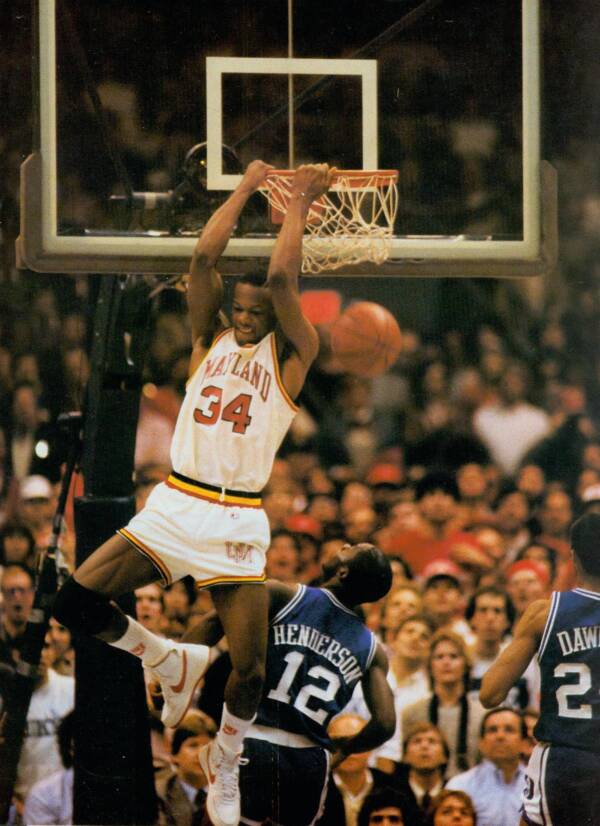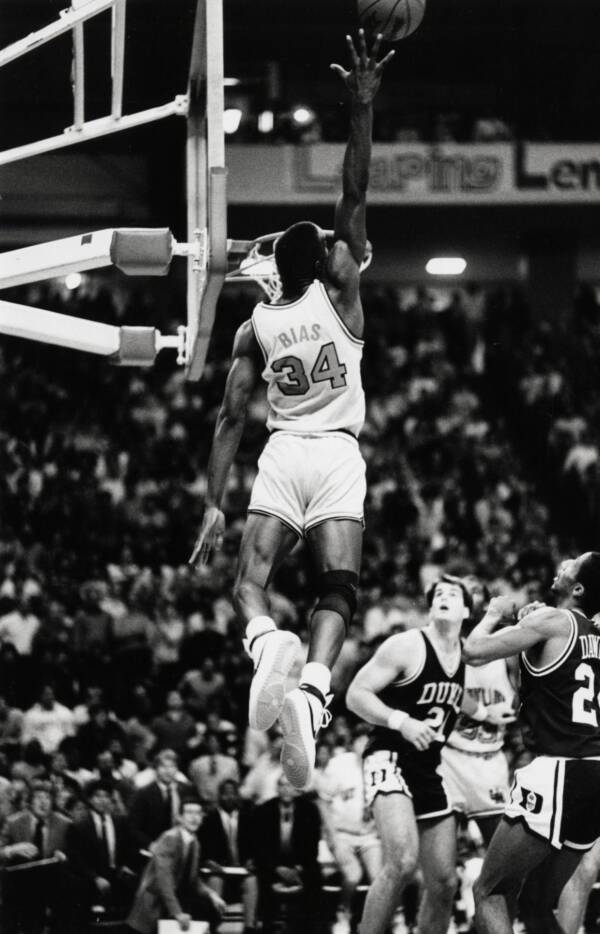College basketball star Len Bias seemed destined to be the next Michael Jordan — then he died of cocaine-induced cardiac arrhythmia just two days after signing with the Boston Celtics in 1986.

Len Bias was just 22 when he died after ingesting “dealer-level quality” cocaine.
On June 19, 1986, one of college basketball’s most promising young players, Len Bias, died from cardiac arrhythmia induced by a cocaine overdose. Two days earlier, he had been selected as the second overall pick in the NBA draft by the Boston Celtics. He was 22 years old. His NBA career ended before it had even begun.
Bias had not been a long-time drug user. He showed no signs of heart complications. In fact, the autopsy revealed that in the hours preceding his death, he had not consumed any alcohol or taken any other drugs — and it’s possible that he died the first time he tried cocaine.
Bias’ death also came at a pivotal moment in the U.S. government’s War on Drugs. In the summer of 1986, crack cocaine was the topic at the forefront of countless mainstream news outlets. And Bias had been one of the most-watched, promising prospects in sports. As a result, he became, in effect, the face of the War on Drugs, despite consuming cocaine as a powder rather than in crack form.
In the end, Len Bias’ death was used to help push anti-drug and anti-crime legislation that unfairly targeted Black Americans. Here’s how it happened.
Who Was Len Bias?
Leonard Kevin Bias was born on November 18, 1963, in Landover, Maryland — just outside of Washington D.C. He was one of four children born to James Bias Jr. and Louise Bias and attended Northwestern High School before graduating and moving on to the University of Maryland, where he was recognized as an All-American player for the university’s basketball team.
According to How They Play’s Jake Robinson, Bias went on to win back-to-back Atlantic Coast Conference Player of the Year honors in 1985 and 1986. At the time, his 2,149 points were a record in Maryland.

TwitterLen Bias has often been compared to another star player from the ACC, Michael Jordan.
When the NBA draft came around in June 1986, the Boston Celtics were at the tail end of a major winning streak — they were wrapping up their third NBA championship in five years.
The Cleveland Cavaliers had the first pick that year and selected Brad Dougherty, the center out of North Carolina. The Celtics’ manager Red Auerbach, however, had his eyes on Bias. When Bias signed with the Celtics, fans were anticipating the start of the young All-American’s NBA career, one that was bound to go down among the greatest in history.
At least, that’s how it should have gone. Instead, Bias’ story ended tragically early, cut short by a few grams of cocaine.
A Death Shocked The Nation
A day after the NBA draft, Len Bias signed a $3 million endorsement deal with Reebok; the company was hoping to use Bias’ stardom to promote their shoes just as Michael Jordan had done with Nike two years earlier. Fresh off of signing the deal and finalizing a few things with the Celtics front office, Bias made a triumphant return to College Park to celebrate.
At some point during the evening, some of Bias’ friends dealt out lines of cocaine, and the young basketball star made the decision, perhaps for the first time, to join them.
At 6:32 in the morning, Bias’ childhood friend Brian Tribble called 911. He was still high — confused and scared; at first, the operator thought it was a prank call. When they realized it wasn’t, an ambulance was dispatched. It arrived at the dorm around 6:40 a.m..

TwitterLen Bias had not been a longtime cocaine user. Many speculate that the night he died may have been his first time trying the drug.
According to a Los Angeles Times report at the time of Bias’ death, Bias had been given “dealer-level quality” cocaine.
“You’re not going to stop on the street corner and get that quality,” said Howard Silverman, the then-acting head of the state Drug Abuse Administration. “You’d have to be pretty well connected.”
In Bias’ car, police found a plastic bag containing roughly 12 grams of cocaine, and in a trash bin outside of the dormitory where Bias and his friends were partying, they found cut straws for snorting cocaine, cocaine crystals, a cognac bottle, and several beer bottles.
Could Len Bias Have Been Saved?
As more information came out, it was revealed that Bias had taken a “high dose” of cocaine and that he had “an average level of sensitivity” to it, which caused him to go into a seizure within “seconds or minutes” of ingesting the drug.
According to Maryland’s chief medical examiner at the time, John Smialek, it would have taken rapid medical attention “by skilled professionals” immediately after going into a seizure in order to save Bias. “It only takes four to five minutes for irreversible brain damage to occur,” Smialek said.

TwitterLen Bias just after signing with the Boston Celtics.
One of the medical attendants who arrived at the dormitory to treat Bias later commented that, based on his body temperature, he likely collapsed 10 to 15 minutes before paramedics were called to the scene. They arrived at the dormitory four minutes after Tribble made the call, but by then it was too late.
“If he had had medical attention within four to five minutes, it’s possible that something might have been done. But I couldn’t say he absolutely would have been able to be saved,” Smialek said.
But despite all of the “what-ifs,” nothing could change the fact that Len Bias, one of the NBA’s most promising newcomers, had died. In the wake of the tragedy, however, lawmakers seized the opportunity to draft anti-drug and anti-crime legislation that harshened sentences for those convicted of drug-related crimes.
Unfortunately, these laws disproportionately affected people of color.
A Symbol Of The Dangers Of Crack Cocaine — Despite Not Using Crack Cocaine
By the summer of 1986, crack cocaine was the biggest issue on the minds of news outlets and politicians. As The Guardian reported, outlets were calling crack cocaine “the biggest story since Vietnam and Watergate” and “the issue of the year.”
So, despite the fact that Bias had ingested powdered cocaine, his death became a cautionary tale highlighting the dangers of using crack cocaine. Democrat House speaker Tip O’Neill, a representative of Boston, sought to use Bias’ death to help push anti-drug bills that would, he hoped, help the Democrats reclaim the Senate.

TwitterAnti-drug legislation put in place after Len Bias’ death came to be known as the Len Bias Laws.
Even committees that had nothing to do with drugs — committees dealing with agriculture, education, and labor, for example — were drafting anti-drug legislation.
Then, just after Labor Day, the House passed a version of the Anti-Drug Abuse Act of 1986, also commonly known as the Len Bias Laws, which furthered mandatory minimum sentences for drug dealers and called for life sentences for dealers whose supply resulted in another person’s death.
Part of the idea, in lawmakers’ eyes, was that crack cocaine had a higher link to crime than other drugs, and fears of an epidemic of “crack babies” were reaching a boiling point. In the years since, however, both of these ideas have been proven false, as reported by The Guardian and the Drug Policy Alliance.
Furthermore, prior to the incorporation of the Len Bias Laws, the average federal drug sentence for Black Americans was 11 percent higher than for white Americans. After the Len Bias Laws took effect, that number skyrocketed to a staggering 49 percent.
The reason for this was two-fold. Black Americans are more likely to be convicted of crack-related crimes, whereas white Americans are more likely to be convicted of crimes related to powdered cocaine. But because anti-drug laws focused mostly on crack cocaine, more Black Americans faced severe criminal charges for drug-related crimes
Racial bias can’t be ignored, either. As The Guardian reports, white Americans are less likely to be prosecuted for drug offenses than Black Americans, and less likely to be sent to prison if convicted.
Fortunately, in recent years the Obama and Biden administrations have worked to correct the sentencing disparity between crack cocaine and powder cocaine adjacent crimes. Still, that doesn’t erase the nearly four decades of unfair treatment that came before.
After learning about the tragic death of Len Bias, read about the death of NFL star Aaron Hernandez and his fall from grace. Or, read the story of Arnold Rothstein, the first modern drug lord and fixer of the 1919 World Series.





